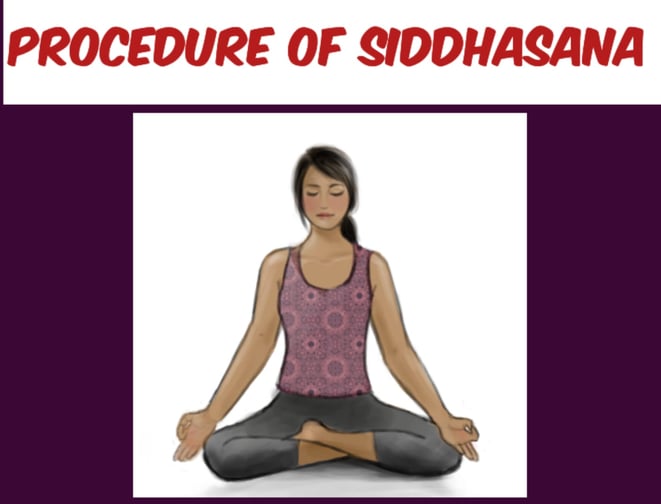

Procedure of Siddhasana
Siddhasana, also known as the “Accomplished Pose” or “Perfect Pose,” is a seated yoga posture that is highly valued for its role in promoting physical stability, mental focus, and spiritual growth. The procedure for performing Siddhasana requires attention to alignment, breathing, and mental focus to achieve its full benefits. Below is a step-by-step guide to performing Siddhasana correctly. 1. Preparation: Before entering Siddhasana, it is important to prepare the body and mind. Begin by sitting in a comfortable, quiet space where you won’t be disturbed. Ensure that the area is clean and free of distractions. You may want to use a yoga mat, cushion, or blanket for added comfort. 2. Assume a Comfortable Seated Position: Start by sitting on the floor with your legs extended in front of you. Ensure that your spine is straight, shoulders are relaxed, and your body is grounded. You can use a cushion or bolster beneath your hips if you have tight hips or difficulty maintaining an upright posture. This will help elevate your pelvis and provide more comfort in the pose. 3. Position the Feet: In Siddhasana, the legs are crossed in a specific way. Begin by bending your right knee and bringing your right foot toward your left thigh. Place the sole of your right foot against the inner thigh or groin area of the left leg. Then, bend your left knee and place your left foot on top of the right foot so that the left heel is pressing against the perineum (the area between the genitals and anus). The key here is to ensure that both feet are positioned securely in a way that allows for a stable foundation. The soles of the feet should be in contact with the inner thighs or groin area, and the heels should be close to the pelvic area. This configuration is important for proper alignment and energy flow. 4. Adjust the Knees and Hips: Once your feet are positioned, ensure that your knees are gently pressing down toward the floor. The knees should be as close to the ground as possible without forcing them. Your hips should be open, with the weight of your body evenly distributed on both sides. It is essential to maintain a sense of ease and comfort in this position, as forcing the posture may lead to discomfort or strain. 5. Align the Spine: Straighten your spine by elongating it upward. Imagine a line of energy extending from the crown of your head through the spine and out the tailbone. Avoid slouching or leaning forward. Your spine should be erect, yet relaxed. Keep your shoulders relaxed and away from your ears, and gently draw your shoulder blades toward your back to open the chest. This alignment will help facilitate smooth energy flow during your practice. 6. Place Your Hands: Place your hands on your knees or thighs with your palms facing upward or downward, depending on your preference. If you are using Siddhasana for meditation, it is common to position the hands in a mudra (a symbolic hand gesture) such as Chin Mudra (thumb and index finger touching) or Dhyana Mudra (hands resting on the lap, one on top of the other, palms facing up). This helps create a sense of stillness and focus. 7. Focus on the Breath: In Siddhasana, breath awareness is a vital component of the practice. Begin by inhaling deeply through the nose, allowing the breath to fill the lungs completely. Exhale slowly, releasing any tension or stress. Focus on the natural flow of breath, allowing the inhale and exhale to be smooth and even. The breath should be deep and controlled to help calm the mind and activate the parasympathetic nervous system. 8. Maintain a Soft Gaze or Close the Eyes: Once you have assumed the posture and are focused on your breath, you can either maintain a soft gaze toward the tip of your nose or close your eyes gently. Closing the eyes allows for better internal focus and helps you tune into your inner state. 9. Stay in the Pose: Remain in Siddhasana for as long as you feel comfortable, typically between 5 and 15 minutes, or even longer if you are using the pose for meditation. During this time, continue to maintain your focus on your breath and the stillness of your body. If you are meditating, allow your mind to settle into a state of calm and awareness. If practicing pranayama (breathing exercises), follow the specific breath pattern associated with your practice. 10. Ending the Pose: To release from Siddhasana, slowly and mindfully uncross your legs and extend them in front of you. Gently stretch your legs and allow your body to relax. You may want to shake out your legs or perform a counterpose like Sukhasana (Easy Pose) to release any tension. Tips for Proper Alignment and Comfort: i. Engage the Core: Keeping the core slightly engaged will help you maintain an upright posture and protect your lower back. ii. Do Not Force the Knees: Avoid pressing the knees to the ground forcefully. If you experience discomfort, consider using props like cushions or blocks under your knees to provide support. iii. Breathing: Focus on long, deep breaths to enhance the effects of the practice and support relaxation. Conclusion: Siddhasana is a powerful yoga posture that promotes physical alignment, mental clarity, and spiritual growth. Its procedure is relatively simple, but achieving the correct alignment requires attention to detail and mindful awareness. By practicing this posture regularly, you can improve flexibility, enhance concentration, and cultivate a deeper sense of peace and presence during meditation or pranayama practices.
YOGA
2/6/20251 min read
